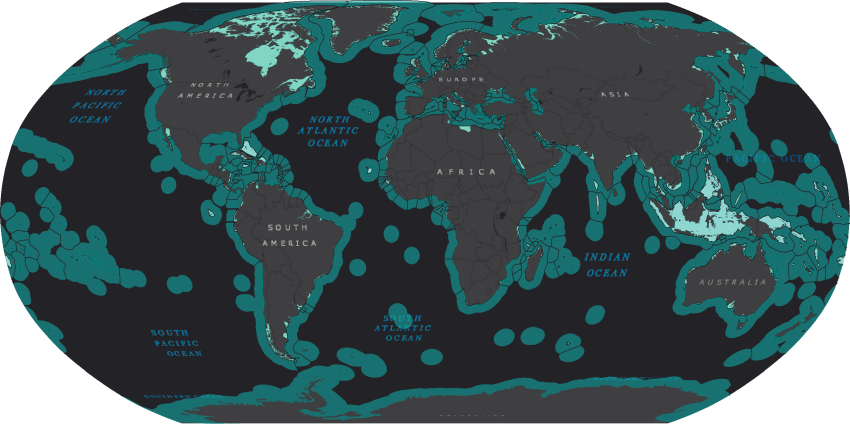New release: version 10 of the Maritime Boundaries
MarineRegions.org is proud to launch version 10 of the Maritime Boundaries Geodatabase.

In this new release, Marine Regions updates the global Exclusive Economic Zones (EEZ) (version 10), and launches version 2 of the datasets for Territorial Seas (TS), Contiguous Zones (CZ), Internal Waters (IW) and Archipelagic Waters (AW).
The maritime boundaries and areas are calculated from the publically available baselines. The global baseline used in this new version is a combination of the straight or archipelagic baselines and the coastline as a proxy for the low-water line. The source for the straight baselines is a combination of the United Nations repository on maritime claims and national legislation on maritime delimitations and agreements. The ESRI Countries 2014 database has been used as the primary source for the Maritime Boundaries coastline. The coastline was further updated with reefs data extracted from Coral Reef Distribution UNEP for the countries where reefs were fundamental for the correct calculation of the maritime areas, as intended by the coastal state.
Marine Regions released the first version of the World’s EEZ in 2007. In the past decade the number of users has increased from a few hundreds to more than one hundred thousand unique visitors per year. The Marine Region’s Maritime Boundaries and it’s unique identifier have become a standard for many users from academia, to industry, and to civil society. Today, the Maritime Boundaries dataset is used in various ways such as a geographic backbone for the World Register of Marine Species, as a geo-unit to calculate fishing activities, or as an assessment unit for the health of our ocean.
With the new release, we hope to further serve the global marine user community working on geospatial analysis. As Marine Regions depends on data and knowledge sharing from global, European, regional and national data providers and relevant experts, we aim to set up Collaboration Agreements with our users and data providers. An example template of a Collaboration Agreement can be found online, please contact info@marineregions.org if your organization is interested to explore this collaboration.
All datasets from marineregions.org’s Maritime Boundaries Geodatabase continue to be the only freely-available global datasets on the World’s Maritime Boundaries.

The maritime boundaries and areas are calculated from the publically available baselines. The global baseline used in this new version is a combination of the straight or archipelagic baselines and the coastline as a proxy for the low-water line. The source for the straight baselines is a combination of the United Nations repository on maritime claims and national legislation on maritime delimitations and agreements. The ESRI Countries 2014 database has been used as the primary source for the Maritime Boundaries coastline. The coastline was further updated with reefs data extracted from Coral Reef Distribution UNEP for the countries where reefs were fundamental for the correct calculation of the maritime areas, as intended by the coastal state.
Marine Regions released the first version of the World’s EEZ in 2007. In the past decade the number of users has increased from a few hundreds to more than one hundred thousand unique visitors per year. The Marine Region’s Maritime Boundaries and it’s unique identifier have become a standard for many users from academia, to industry, and to civil society. Today, the Maritime Boundaries dataset is used in various ways such as a geographic backbone for the World Register of Marine Species, as a geo-unit to calculate fishing activities, or as an assessment unit for the health of our ocean.
With the new release, we hope to further serve the global marine user community working on geospatial analysis. As Marine Regions depends on data and knowledge sharing from global, European, regional and national data providers and relevant experts, we aim to set up Collaboration Agreements with our users and data providers. An example template of a Collaboration Agreement can be found online, please contact info@marineregions.org if your organization is interested to explore this collaboration.
All datasets from marineregions.org’s Maritime Boundaries Geodatabase continue to be the only freely-available global datasets on the World’s Maritime Boundaries.




